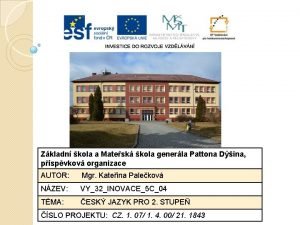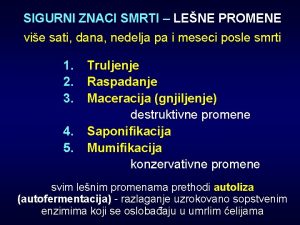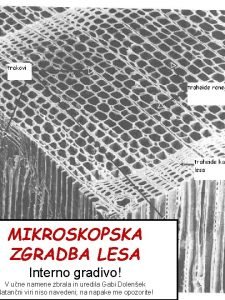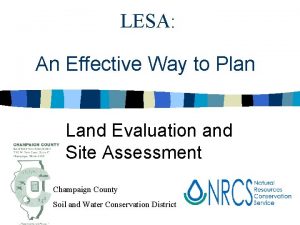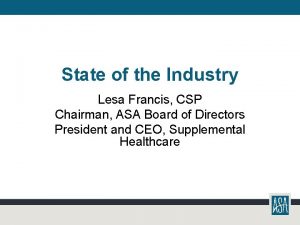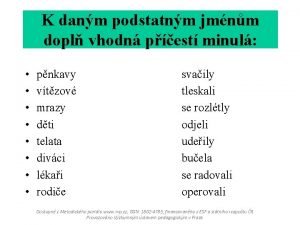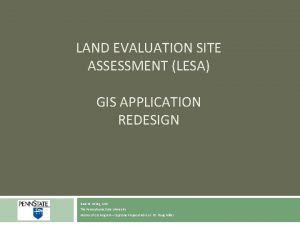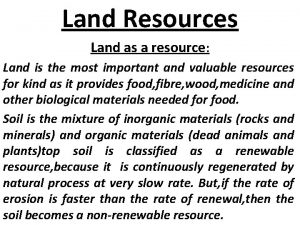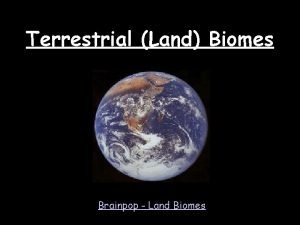LESA An Effective Way to Plan Land Evaluation

















- Slides: 17

LESA: An Effective Way to Plan Land Evaluation and Site Assessment Champaign County Soil and Water Conservation District

What is LESA? u. A two-part evaluation system • soil productivity • social/economic/environmental factors

LESA. . . u. Science/Fact-based u. Decisions process are consistent, accurate and defensible.

Where Do We Start? u. LESA is already in place -NRCS & SWCD began the program 16 years ago. u. LESA should be updated and used

LESA: A 2 -Part Process u Land Evaluation (LE) – SWCD-NRCS provides soils data, ranking for productivity u Site Assessment (SE) – Local officials rate land current farm activity • surrounding nonurban land use • distance to utilities and transportation • other crucial local issues

LESA: LE portion Land Evaluation (LE) Based in soil productivity Index with 100 as best soils (Flanagan) u 9 soil productivity groups u SWCD recommends saving top 4 groups (85) u Average for site 1/3 of total score (0 -300)

LESA: SA portion Site Assessment (SA) Suitability of site for development and interface with agricultural community Agricultural land use nearby u Current zoning nearby u Compatibility and proximity to towns u Land use feasibility u Available resources-roads, water, sewer, etc. u Environmental impact u Total points 2/3 of LESA score (0 -300) u

LESA: Adding it up Total Score = 0 to 300 Combining the soil productivity and impact of development on agriculture, the environment and existing infrastructure LE + SA= LESA u Scoring system 220 -300 very high rating for protection 200 -219 high rating for protection 180 -199 moderate rating for protection 179 or less low rating for protection u SWCD recommends protection if 200 or above u

LESA Can Help You. . . n Identify farmland in need of protection n Aid in planning and zoning policies n Evaluate proposed or future conversion issues

Green areas LE > 85 Prime farmland definition Brown areas LE < 85 Gray areas = 19% Undeveloped land

Example A LE = 80 LESA close to town = 136 LESA away from town = 226

Example B LE = 86 LESA close to town = 152 LESA away from town = 232

Example C LE = 99 LESA close to town = 169 LESA away from town = 239

Why Should We Use LESA? n n n LESA is science-based LESA can make planning easier LESA is consistent for all tracts in the county

Where do we go from here? u Update scoring sheet to reflect current needs u Make the system known to people considering development so they can see if their project is feasible

Who Else Supports LESA? NRCS, the Champaign Co. SWCD, and Farm Bureau endorse LESA and the use of comprehensive planning/zoning policies

For more information on how LESA can help your community, contact your local USDA Service Center and speak with NRCS and SWCD resource professionals today!
 Jak se do lesa volá tak se z lesa ozývá vedlejší věta
Jak se do lesa volá tak se z lesa ozývá vedlejší věta Jak se do lesa volá tak se z lesa ozývá vedlejší věta
Jak se do lesa volá tak se z lesa ozývá vedlejší věta Saponifikacija leša
Saponifikacija leša Zgradba lesa
Zgradba lesa Mechové patro
Mechové patro Lesa an
Lesa an Jak šlo šídlo do lesa
Jak šlo šídlo do lesa Ptáci okraje lesa, křovin a otevřené krajiny
Ptáci okraje lesa, křovin a otevřené krajiny Lesa francis
Lesa francis Tropické deštné lesy zvířata
Tropické deštné lesy zvířata Relocating loader advantages and disadvantages
Relocating loader advantages and disadvantages Patrovitost tropického lesa
Patrovitost tropického lesa Andrea slan
Andrea slan Společenstvo lesa
Společenstvo lesa Patrovitost
Patrovitost Brzy ráno vyšli houbaři do lesa
Brzy ráno vyšli houbaři do lesa Potravní řetězec
Potravní řetězec What are landforms
What are landforms

